Nvidia Ampere - RTX 3090, RTX 3080, and RTX 3070 release date, specs, performance, and pricing
The new RTX 30-series graphics cards have been announced... and they're gaming, ray tracing monsters.
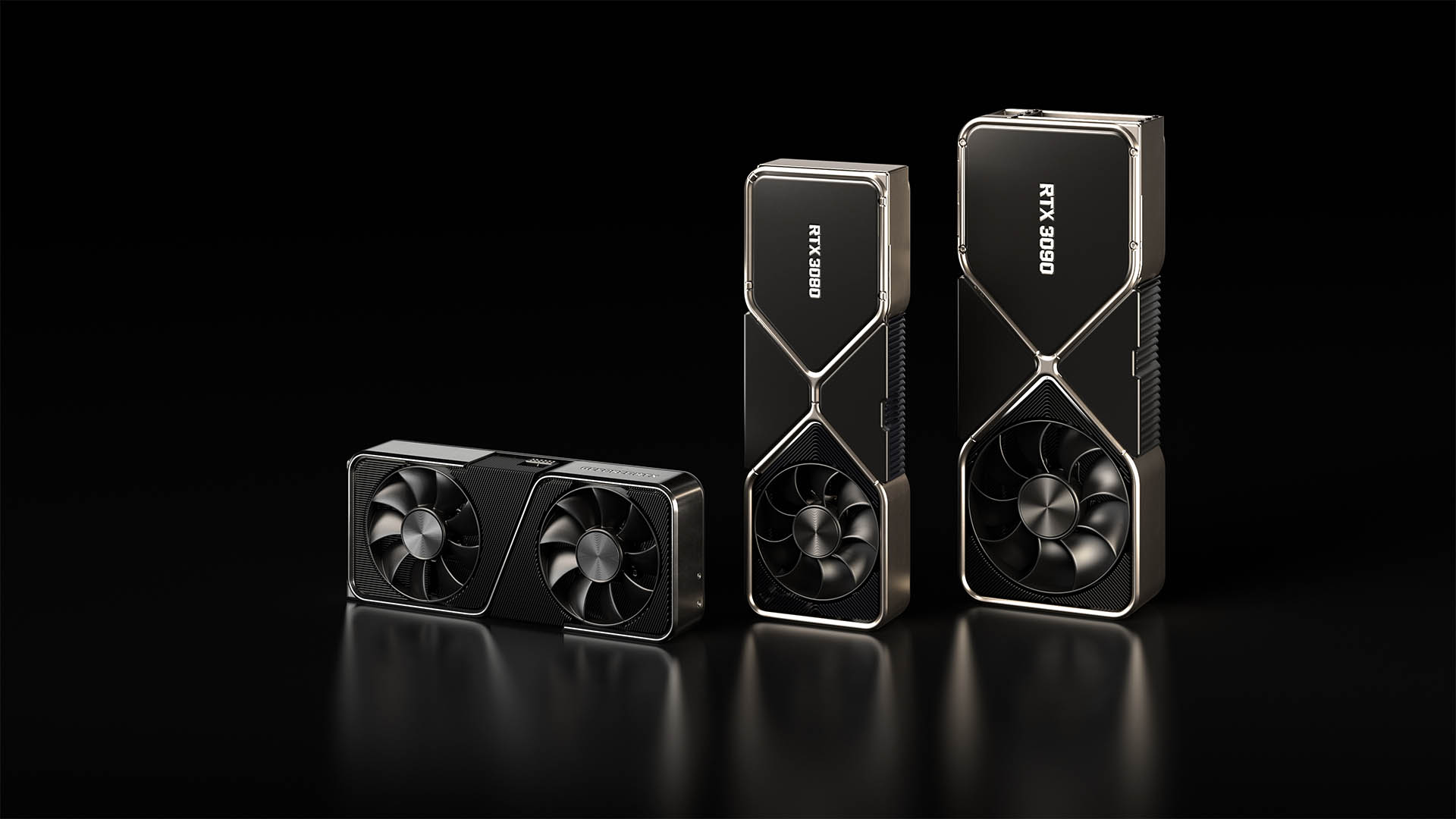
The new Nvidia Ampere cards have finally been unveiled and the RTX 3090, RTX 3080, and RTX 3070 look like absolute monsters. Even the lowest spec, lowest priced of the second-gen RTX cards is able to outperform what was yesterday the fastest consumer graphics card in the world. Anyone that bought an RTX 2080 Ti in the last few months is going to be crying into their RGB-lit keyboard right now.
Effusive CEO, Jen-Hsun Huang, is calling Nvidia Ampere "the greatest generational leap" the company has ever made, and from the performance boasts Nvidia is making that doesn't sound like too much bluster.
The RTX 3080 is up to twice as fast as the RTX 2080, and considerably quicker than the RTX 2080 Ti.
We might not spend too much time talking about that BFGPU, the RTX 3090. That's a "because we can" behemoth, which frankly frightens me and the test rig I'm going to be balancing its considerable girth atop. It's also some $1,499 for the triple-slot reference card alone, which makes it the most-expensive GeForce card released since the $3,000 dual-GPU GeForce GTX Titan Z.
The top two cards are set to land in September, with the actually more interesting card, the RTX 3070, not scheduled to hit the shelves until sometime in October. When it comes to the more mainstream GPUs—the RTX 3060 et al.—we're not expecting to see them until some time in the new year.
Though, as the rumour mill is wont to do, future cards are being bandied around in the form of the 16GB RTX 3070 Ti, a potential stop-gap card in between the RTX 3080 and RTX 3070.
At a glance…
Nvidia Ampere RTX 30-series release date
The flagship Nvidia RTX 3080 is being launched first, on September 17, with the Titan-eqsue RTX 3090 coming later on September 24. The most affordable of the three new Ampere GPUs, the RTX 3070 is slated for launch in October.
Keep up to date with the most important stories and the best deals, as picked by the PC Gamer team.
Nvidia Ampere RTX 30-series specs
The new GeForce RTX Ampere GPUs come with an astounding core count, double what was originally rumoured. With twice the FP32 units, the RTX 3090 has 10,496 CUDA cores, the RTX 3080 has 8,704, and the RTX 3070 has 5,888 CUDA cores inside it. The memory capacity is also relatively chunky with 24GB, 10GB, and 8GB of either GDDR6X or GDDR6 respectively.
Nvidia Ampere RTX 30-series performance
The green team is touting a 1.9x performance-per-Watt improvement over Turing, which means that to hit 60fps you'll need almost half the power. But who wants to stand still? The RTX 3090 is reportedly 1.5x faster than the Titan RTX, the RTX 3080 is up to twice as fast as the RTX 2080, and the RTX 3070 can outperform the RTX 2080 Ti.
Nvidia Ampere price
At the top end of the stack the RTX 3090 is a massive $1,499 for the reference card. Eeep. The other cards are more reasonable, with the RTX 3080 coming in at $699 and the impressive-looking RTX 3070 at $499.
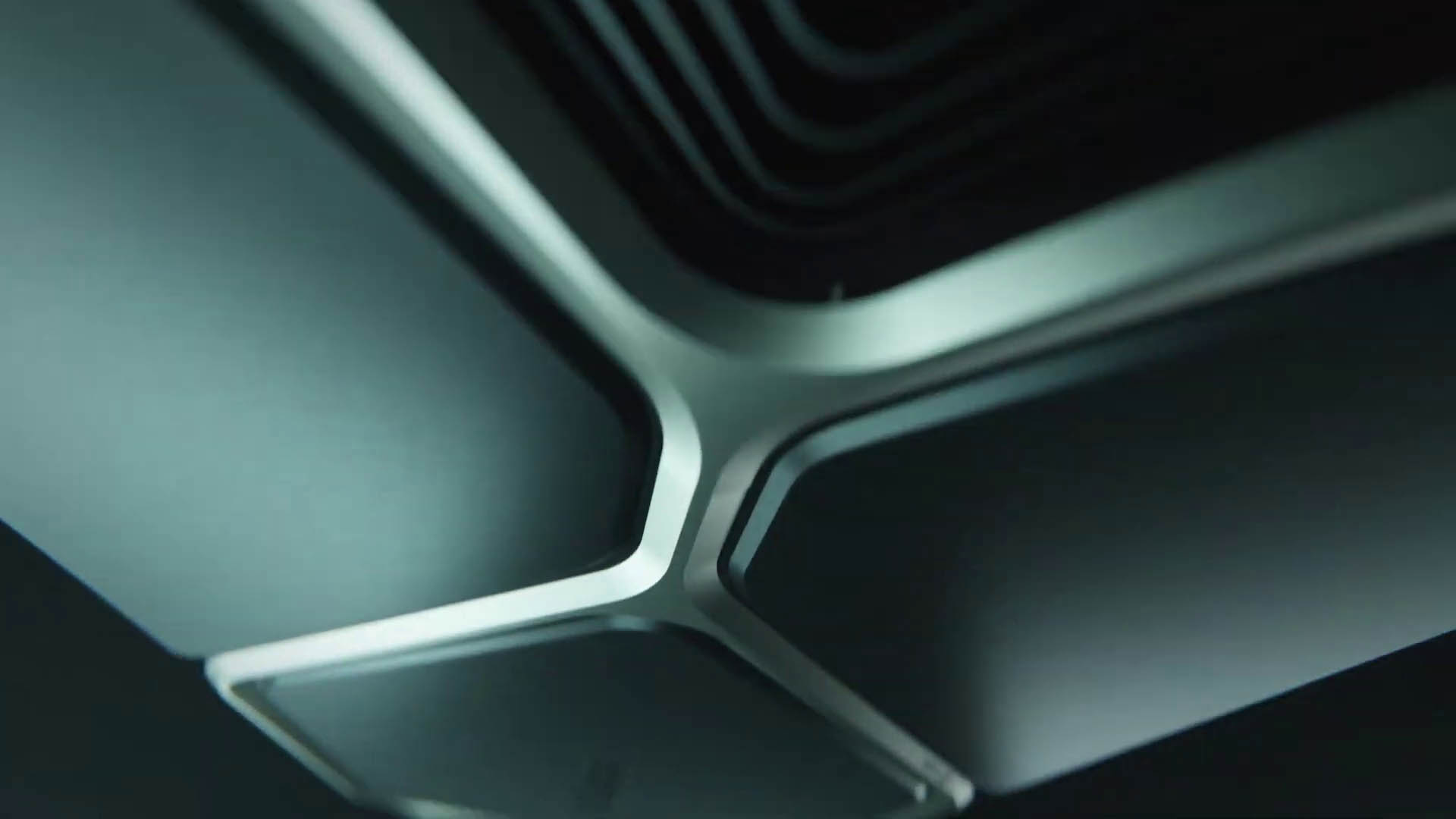
Release date
The RTX 3080 release date is September 17, making it the first of the new Nvidia Ampere GeForce GPUs to hit the shelves. It's the card that Jen-Hsun Huang referred to as "our new flagship GPU" and so it's the one being put front and centre with the new second-gen RTX launch.
The RTX 3090 release date is September 24, following hot on the heels of the far more reasonably priced card. This is the new ultra-enthusiast class GPU that Nvidia is noting as effectively the new, more widely available Titan card.
The final piece of the initial jigsaw is the RTX 3070, with a far more vague release date of sometime in October. This is arguably the most intriguing Ampere card for gamers because it's offering straight performance that is higher than the RTX 2080 Ti for less than half the price.
Those are the stated release dates for the Founders Edition reference cards from Nvidia, but what we don't know is how quickly the add-in board partners (AIBs) are going to get their own myriad designs out of the factories and into the shops. Normally you'd expect there to be a month delay on the AIB cards, but I've got a feeling we'll see at least the reference clock cards just after the main launch.
The factory-overclocked versions might be a little later, so they may not arrive until a month later than the standard cards. But you can expect to see some shiny, innovative cooling solutions dropped on the new Ampere GPUs pretty rapidly.
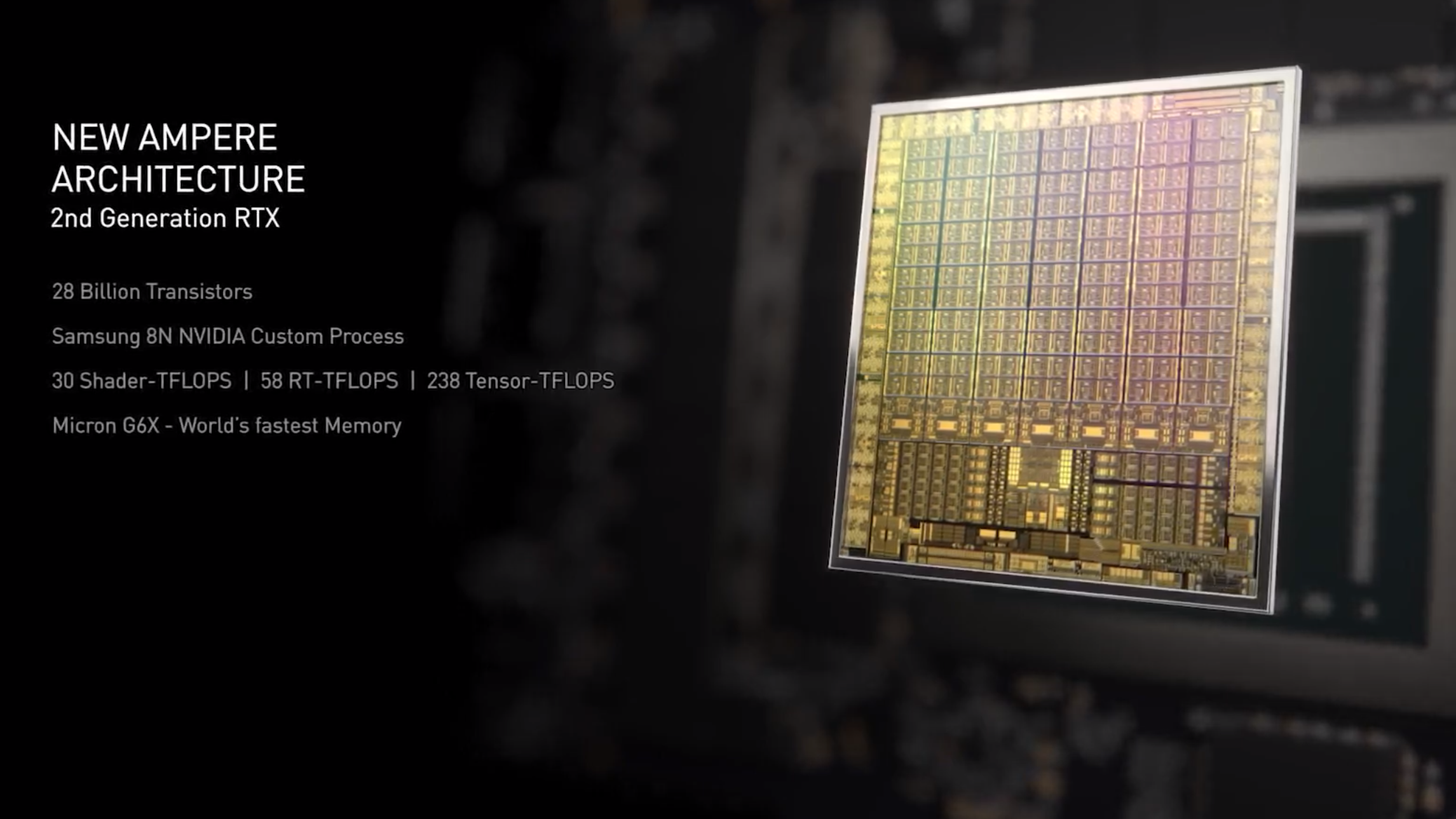
GPU Specs
Finally we've got the official specs for each of the new Nvidia Ampere graphics cards, and they're a little different to what had been rumoured. To the tune of twice the CUDA core count. Though that's not strictly true; one rumour from last year did hint that the Ampere GPUs would feature twice the FP32 cores compared with the Turing equivalents.
And that has indeed come to pass, with the top-end RTX 3090 rocking up with more than 10,000 CUDA cores because of it. That's actually more than the official specs of the GA100 GPU used in the top-end professional cards, like the $12,500 Nvidia A100 PCIe card.
The pro-cards have a whole lot of die space taken up with FP64 cores, and it looks like either Nvidia has replaced the fixed function double precision logic with specific single precision versions, or the Ampere schedulers are capable of using that same dedicated FP64 silicon and instead using it for FP32 maths instead.
| Graphics Card Name | RTX 3090 | RTX 3080 | RTX 3070 |
|---|---|---|---|
| GPU Name | Ampere GA102-300 | Ampere GA102-200 | Ampere GA104-300 |
| Process Node | Samsung 8N | Samsung 8N | Samsung 8N |
| CUDA Cores | 10,496 | 8,704 | 5,888 |
| Boost Clock | 1,700 MHz | 1,710 MHz | 1,730 MHz |
| Memory Capacity | 24 GB GDDR6X | 10 GB GDDR6X | 8 GB GDDR6 |
| Memory Bus | 384-bit | 320-bit | 256-bit |
| Bandwidth | 936 GB/s | 760 GB/s | 512 GB/s |
| Memory Speed | 19.5 Gbps | 19 Gbps | 16 Gbps |
| TDP | 350W | 320W | 220W |
| Recommended PSU | 750W | 750W | 650W |
| Price | $1,499 | $699 | $499 |
| Release date | September 24 | September 17 | October |
Whatever the fine details, we'll know more of everything when the whitepapers and architecture deep dives have been published. For now though, suffice to say the RTX 3090 is rocking 10,496 CUDA cores, the RTX 3080 has 8,704, and the RTX 3070 has 5,888. Compare that last with the RTX 2080 Ti and its miserly 4,352 CUDA cores and you can see why the new $499 card is beating Turing's top $1,200 GPU.
The GPU itself is built on a slightly different production process to the professional Ampere chips too, with the 7nm TSMC design being ditched for the second-gen RTX cards in favour of Samsung's 8nm node, codenamed 8N. There were old rumours that Samsung was offering serious discounts on manufacturing orders, which might well have enticed the green team into making the switch for the GeForce GPUs.
But it's not just about the GPU silicon itself as the memory subsystem is important too, and Nvidia has employed the new GDDR6X memory standard for its top two cards. The RTX 3090 has 24GB GDDR6X, running across a 384-bit bus, while the RTX 3080 has 10GB situated on an aggregated 320-bit memory bus.
The RTX 3070, however, is sticking with 8GB GDDR6 instead, itself running across an aggregated 256-bit memory bus.
Nvidia hasn't published the memory speeds on its site, but we're pretty confident that we're looking at 19.5Gbps, 19Gbps, and 16Gbps respectively. Either way, that's a lot of fast memory however you look at things.
Power has been a big talking point ahead of the full announcement, and those cute little 12-pin power connectors, with much being made of the expectation that Ampere's RTX cards will house incredibly power-hungry and hot GPUs. Looking at the cooling solutions being employed you can kinda see why, and that's born out by the official card specs too.
With a 350W TGP, the RTX 3090 certainly wants a lot of juice, though the 320W TGP of the RTX 3080 is nothing to be snorted at either. The RTX 3070 is a little more parsimonious about its power demands, however, sitting pretty at 320W. Nvidia's recommended PSU specs for the three cards run at 750W for the top two, and 650W for the RTX 3070.
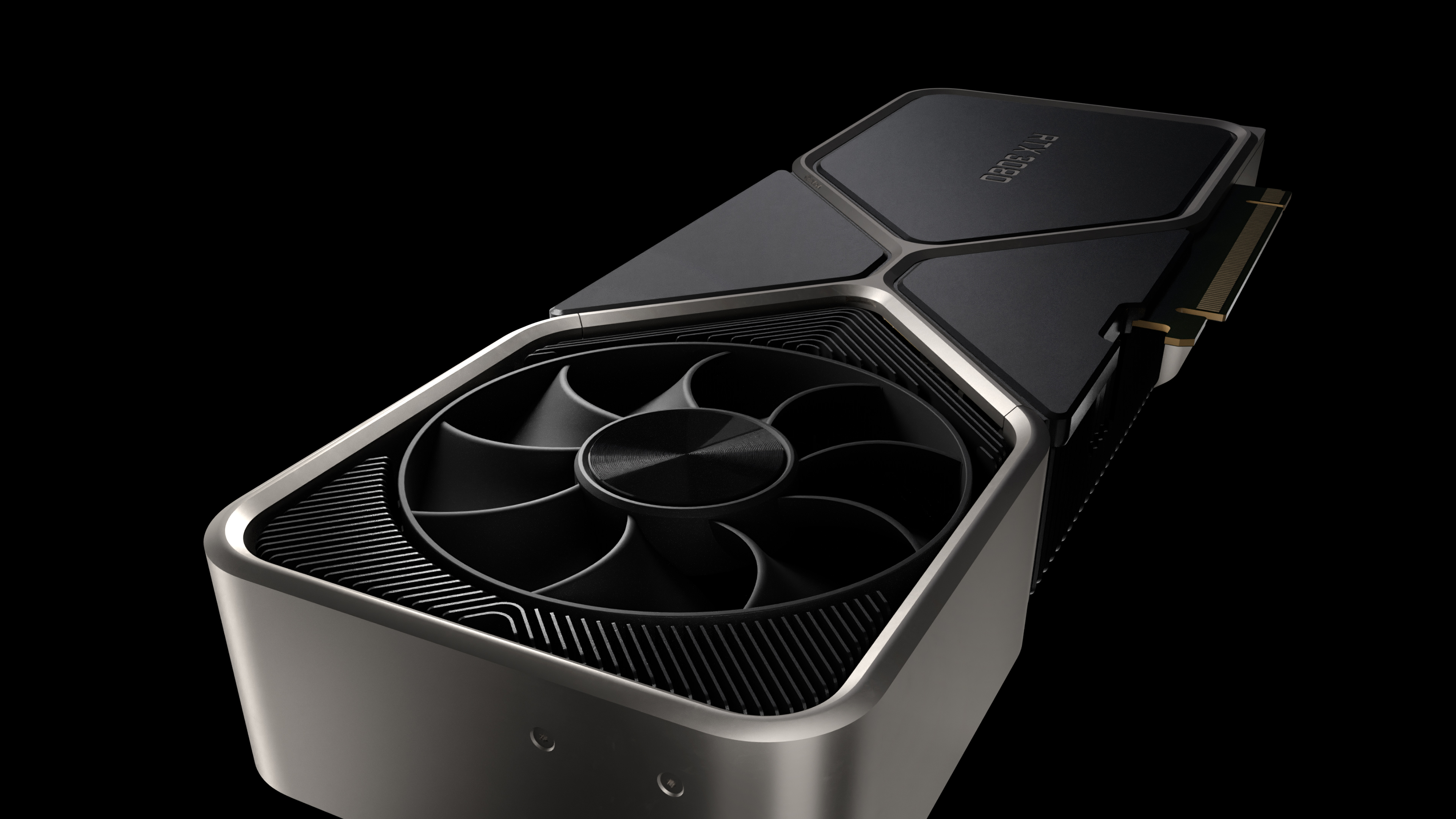
Performance
The actual performance of the RTX 30-series cards is only going to be fully realised once we get the silicon in our hands. Which should be very soon. But, until then, all we have to go on is what Nvidia claims, and those figures are seriously impressive.
The headline Ampere spec is that 1.9x performance-per-Watt number, but that's nowhere near as sexy as the claim that the $499 RTX 3070 can actually outperform the $1,200 RTX 2080 Ti. Which is why we keep mentioning it. If that claim works out in gaming reality then the noises about the "greatest generational leap" might just ring true.
The RTX 3080, what Nvidia is calling the flagship of the GeForce RTX 30-series, is also therefore quicker than an RTX 2080 Ti, with the company claiming performance up to twice that of the standard RTX 2080. And that card it's ostensibly replacing is no slouch either.
At the top is the BFGPU, the so-called 'Big Ferocious GPU', which is claimed to be up to 1.5x faster than a Titan RTX. Which isn't a gaming card anyways, but we'll let them off, because those are still some impressive numbers on the surface.
"The RTX 3090 is so big," says Jen-Hsun Huang, "that for the very first time we can play games at 60 frames per second in 8K."

For most games that's going to mean using DLSS, Nvidia's AI-powered upscaling engine, to achieve those frame rates, but the green team has shown a graph with 13 games running with high graphics settings at 8K and for the most part topping 60fps. The impact of DLSS is particularly highlighted by the Control datapoint; without it you're likely getting single-figure frame rates even with an RTX 3090, but turn it on and it looks like you're just shy of 60fps.
But this being the second-gen RTX unveiling it would be remiss not to talk about ray tracing performance and it looks like the rumours of ditching the RTX penalty are mostly true.
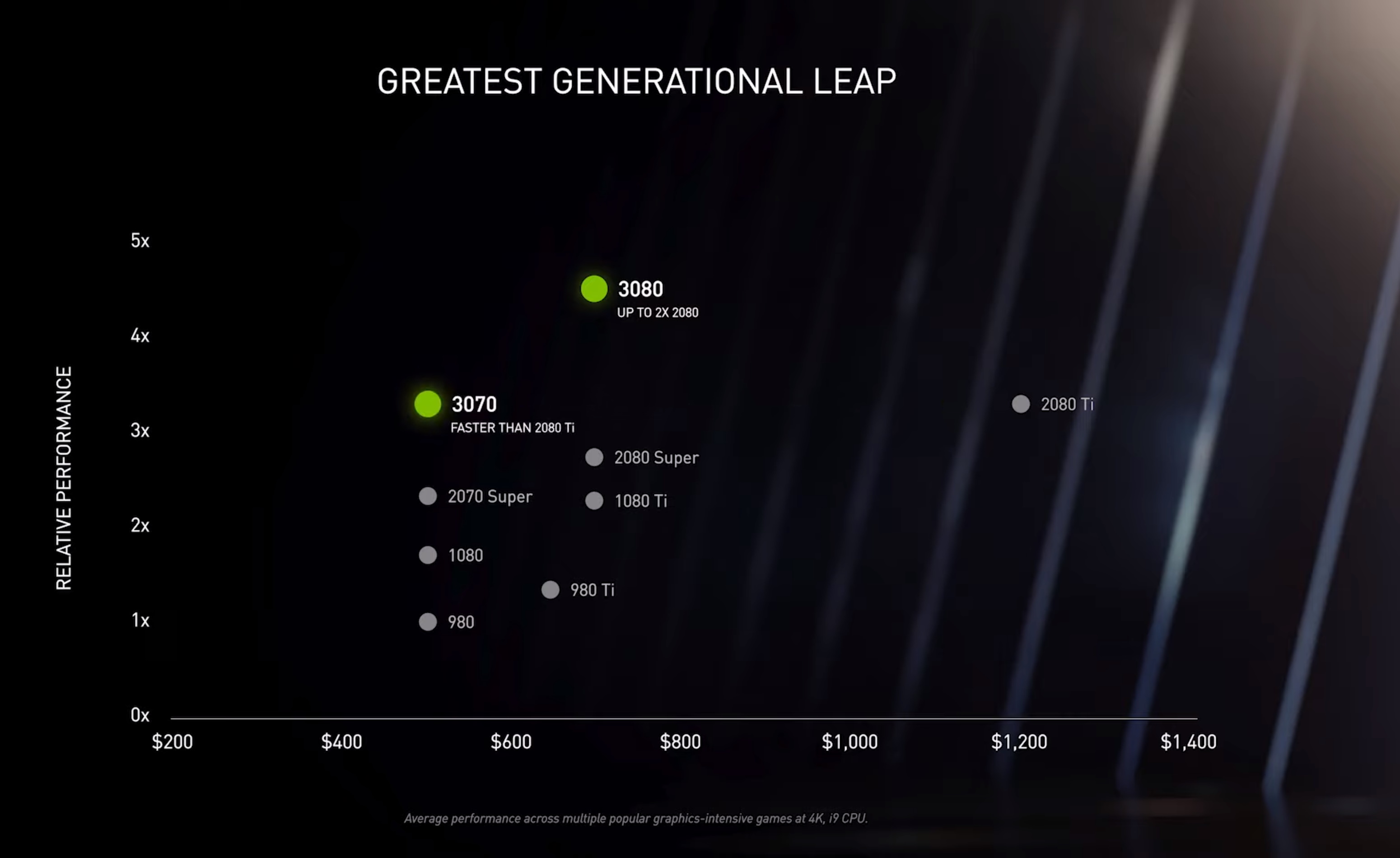

"Once the holy grail of computer graphics," says Huang during the RTX announcement, "ray tracing is now the standard, and Ampere is going to bring you joy beyond gaming."
I mean, it's not quite the standard yet, we'll need a year or so of next-gen consoles bringing ray traced effects to far more games, but at least the hardware looks like it's here. Even the humble RTX 3070 is reportedly capable of topping 60fps at 1440p with ray tracing enabled. That's suggested to be higher performance than a GTX 1080 Ti without RTX on.
The RTX 3080 then is meant to be capable of topping 60fps at 4K with ray traced effects all up in its grill. Versus the RTX 2080 Super Nvidia is claiming that you'll see a greater than 1.5x performance improvement in RTX-enabled titles, such as Battlefield V and Control.
The mix of boosted rasterized gaming performance with high-end ray tracing prowess is going to make the new RTX 30-series a real tough act to follow. And that's exactly what AMD is going to have to do with its own AMD RDNA 2 architecture sometime this month.
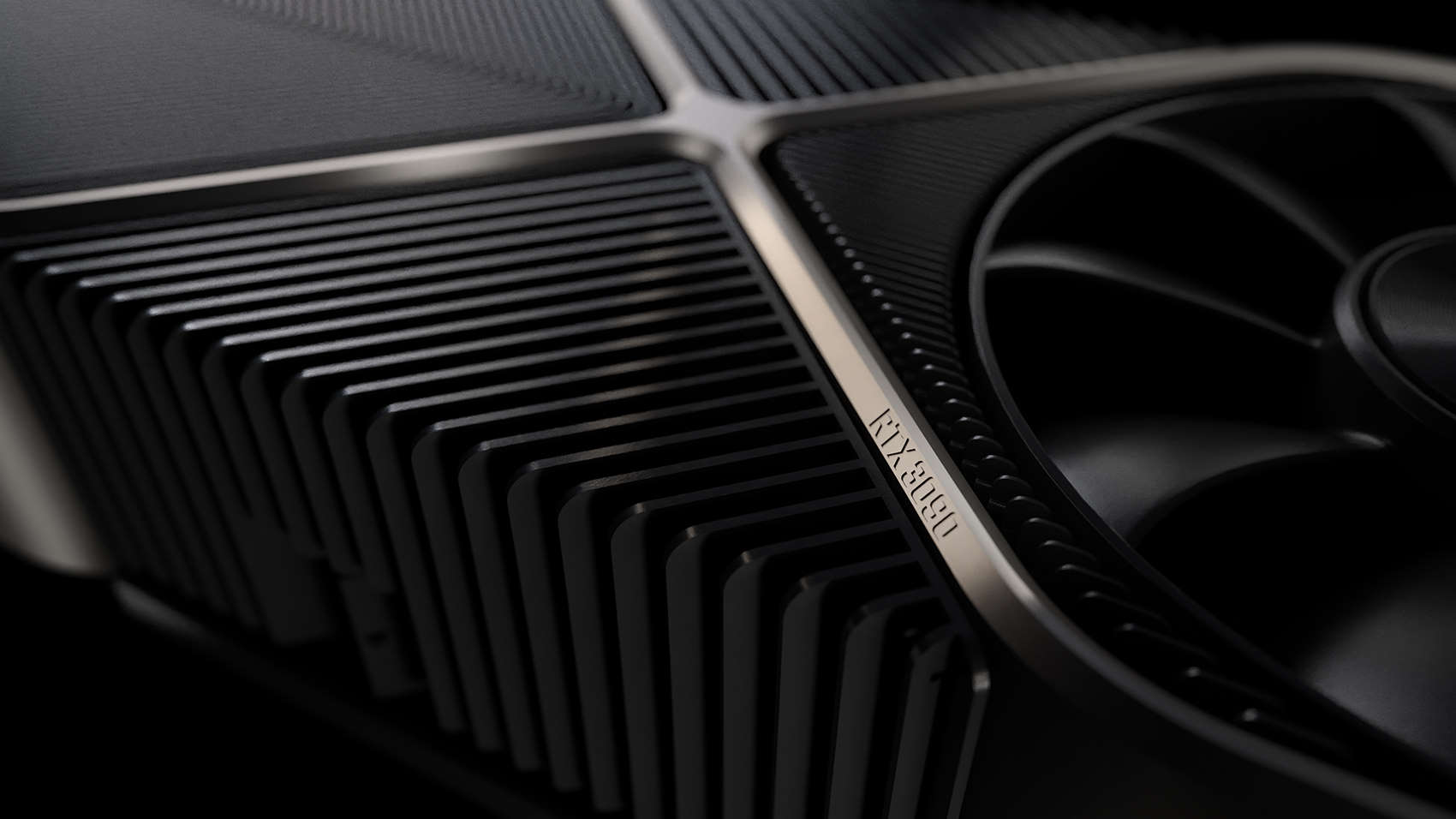
Pricing
Nvidia managed the pricing reveal in a very smart way, wrapping it around a price/performance graph where the first card in the stack, the RTX 3080, was placed well above the RTX 2080 Ti on the performance axis and well below on the price axis. Suddenly that $699 price tag seemed like a great deal compared with the $1,200 RTX 2080 Ti.
It also matches the pricing of both the RTX 2080 Super and GTX 1080 Ti before it. You're getting far more gaming performance from this generation than the equivalent cards of the last two gens.
Then came the reveal of the $499 RTX 3070, more or less on the same performance line as the RTX 2080 Ti, well above the RTX 2080 Super, and yet still placing well below either in terms of pricing. Honestly, it's this card which seems like it's going to be the second-generation RTX darling, and Big Navi is going to have to go some to top it.
And then came the big reveal. The RTX 3090. The bonkers BFGPU, with a price tag that would have been laughed out of Jen-Hsun's spatula-laden kitchen (seriously, did you see how many is in that jar behind him?) had it been revealed first. At $1,499 the RTX 3090 is the company's most expensive single-GPU GeForce card ever. And wouldn't even fit on that prior graph.
But this is, like the RTX 2080 Ti implicitly was, this generation's ultra-enthusiast Titan card. Just with a numerical GeForce RTX nomenclature that makes it seem part of the rest of the gaming gang. Jen-Hsun tried to explain this switch around in the GeForce Special Event as a result of the Titan's demand outstripping its supply, so now Nvidia is making a Titan-esque card widely available. For a titanic price.
"Several years ago, we started building the Titan," he says, "pushing the GPU to the absolute limit to create the best graphics card of that generation. It was built in limited quantities, only through Nvidia. The distribution was limited. The demand surprised us."
And so now any AIB can build what is effectively an Ampere-based Titan, and sell it through standard retail channels.
But it's not the flagship card, despite being the absolute fastest GPU. No, that's the RTX 3090. Such marketing shenanigans are fine when you're still offering a $500 GPU that's as capable as the card which was, until yesterday, the fastest consumer graphics card ever made. So we'll forgive Jen-Hsun that one.

Dave has been gaming since the days of Zaxxon and Lady Bug on the Colecovision, and code books for the Commodore Vic 20 (Death Race 2000!). He built his first gaming PC at the tender age of 16, and finally finished bug-fixing the Cyrix-based system around a year later. When he dropped it out of the window. He first started writing for Official PlayStation Magazine and Xbox World many decades ago, then moved onto PC Format full-time, then PC Gamer, TechRadar, and T3 among others. Now he's back, writing about the nightmarish graphics card market, CPUs with more cores than sense, gaming laptops hotter than the sun, and SSDs more capacious than a Cybertruck.

